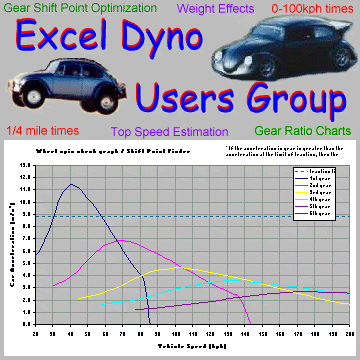

Hi everyone,
Unfortunately this program requries Microsoft excel 2000 or better to run, as it is a fancy excel spreadsheet.
I made it because I wanted to see the effects on acceleration of differnt engines, also the effect of different gearing and tyre sizes. So I made this
spreadsheet from hell. You can caculate just about anything from tyre sizes - gear ratio charts - best shift points - 1/4 mile times - top speed -
plus heaps more.
Check it out, it's hours of fun if your into this sort of thing. It can be downloaded from here.
http://offroadvw.net/exceldyno/
Then if you like it join the new yahoo group I made. The yahoo group will mainly allow me to email the people in the group and tell them when I have
released a new version. If enough people join we could share engine / car / gearbox databases.
http://autos.groups.yahoo.com/group/exceldyno/
So has anyone tried it, did they like it?
Hi Wes,
I've played with it for over a year, and it rocks.
I've just downloaded the 1.0 version and created the Twin-Cab model for it; seems quite reasonable, even for low-performance applications; 1/4
mile in about 23 secs, 0-100 kph in about 25, top at around 130 kph using a CD of 0.45 (guessed...).
Is there a way to edit e.g. the HP at 5000 rpm that I've set up for the engine without creating a new engine model?
Lots of fun and I'm sure very handy for those with less aneamic cars to model!
the best way is to go to the engine worksheet, and play with the power figures there. once the curve looks right then I suggest adding it to the
database for good.
but at the moment you can only delete and add from the database, and not modify. I will look into making that feature.
I've also had suggestions that I be able to save what is on the engine tab, instead of having to retype it on the add engine form. I am currently
looking into this feature.
Thanks for the response :thumb
you guys might like http://www.cartestsoftware.com/cartest4.5/ .
i got this years and years ago, and i highly recommend it. you put in car specific data, then run tests such as gear charts, fuel economy
(surprisingly accurate) drag racing, optimum shift points, hp/torque curves, and lots of other things.
i can only vouch for the dos program, havnt tried their "windows version".
note - by dos program i mean that it will still run in windows, just in a dos box. also works on XP.
So can I add my own vehicles stats?
-Staggers.
As far as I am aware, the drag coefficient, for a 1968~79 VW Kombi, is about 0·75 to 0·80.
The CD for the split screen Kombi was quoted as 0·75, in one automotive technology book, that I read a few years ago.
| Quote: |
Yes Wes.
I am reasonably certain that 0·75~0·80 is a representative drag coefficient for the VW Kombi, bearing in mind that 1·0 is the value for a "bluff
body", which one might interpret as a square-edged brick, with no edge curvature. Don't forget, that even aerodynamically efficient, modern saloon
cars, have drag coefficients of about 0·29~0·33
If you multiplied the drag coefficient, by the frontal area in metres squared, you would obtain an answer of more than three to four times as large,
for the VW Kombi.
Regards.
Nigel A. Skeet, M.Sc. (Applied Energy Engineering), B.Sc. (Applied Physics), B.A. (Applied Mathematics & Statistics), Pg.Dip. (Scientific Applications
Software), P.G.C.E. (Physical Sciences & Mathematics Education)
But a bluff body isn't long. By making something longer you can actually reduce the drag.
I know that in an old Road & Track review of the 1980 VW Vanagon Transporter they quoted "Starting at the front, the shape is more aerodynamically
efficient despite its angular appearance, and VW claims a drag coefficient of 0.44 "
I have also heard many times that the kombi has a lower Cd than a beetle. This site agrees with that and states 0.42 for the VW Microbus.
http://www.velocissima.com/tech/drag.htm
The problem with most stuff posted on the net is that it's from text books from the 50's, so the generic "car", "truck" etc values are really
bad :o
And to return the courtesy, or if your interested ??? my qualifications are...
BE(Mech)Hons MIEAust CPEng :thumb
Pretty boring to most people :P
Jeez Nigel - i think you've been trumped! But don't worry I've seen many Phd's that have been wrong
hey wes
just wanted to say thanks for such and awesome program, I have been spending way too much time on it and am learning a fair bit about gear boxes,
ratios and combinations at the same time.
Great program, I hope you dont mind, I have sent it to a few guys who are interested for them to have a play too.
BLAST FROM THE PAST!
This is mad Wes!
One thing i'll say, i used to consider myself as knowing how to use a computer fairly well, until i saw this!
How'd ya do it?
And look at that pic.. another blast from the past...
